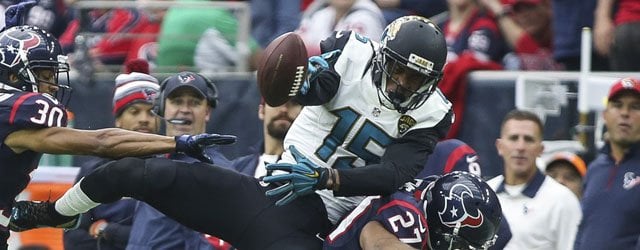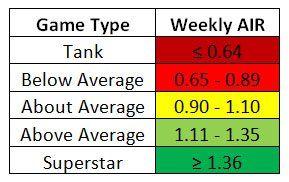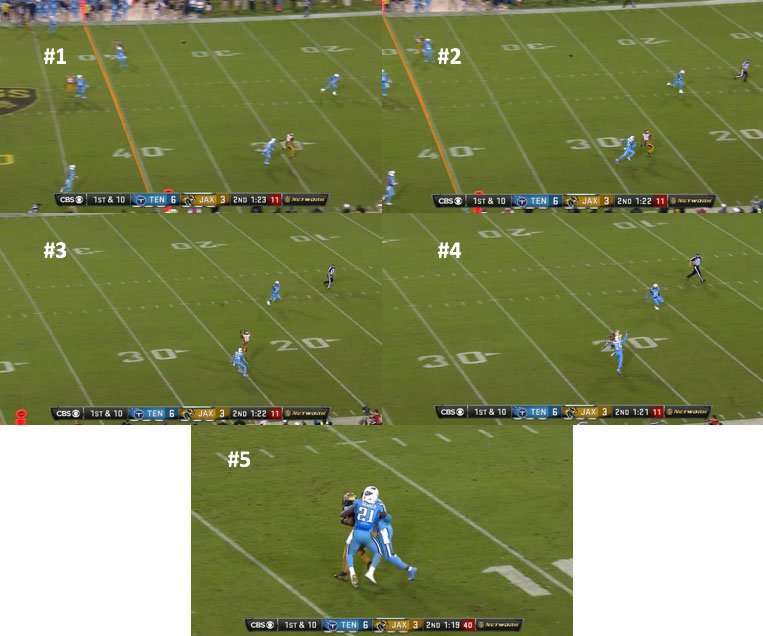Here’s to you Mr. Robinson

My fantasy teams love you more than you will know…
Every off-season we witness an inordinate amount of dynasty hype trains leaving the station. Many are warranted and chug along full steam ahead, while others crash and burn only moments into their respective voyages. The 2015 off-season was no different, and considering the plethora of talented rookies, perhaps even more intense than usual.
One such former freshman was Jacksonville receiver Allen Robinson. Despite a truncated season that concluded in a broken foot (stress fracture) after 10 games, Robinson routinely found himself as a third round pick in summer startups. Not surprisingly, such a high-profile rise to prominence resulted in both supporters and detractors stating their respective cases.
Proponents, such as myself, pointed out that despite being extremely young (just 21 entering the season) and having missed nearly the entire off-season, the former Penn State product quickly emerged as quarterback Blake Bortles’ favorite target. From week three onward Robinson sequestered at least seven targets in every remaining game, with double-digit looks in four of eight games. As friend of DLF and one of the smartest writers in the business, Adam Harstad of footballguys.com, has espoused numerous times, one of the greatest predictors of future workload is prior workload.
[am4show have=’g1;’ guest_error=’sub_message’ user_error=’sub_message’ ]
Digging into the numbers, however, certainly provided the anti-Allen crowd with fuel for their fire. Despite only averaging a meager 11.4 YPR, Robinson converted under 60 percent of his 81 targets, with only two resulting in scores. This was both noteworthy and surprising, since Robinson was nearly three yards better on a per-catch basis in college, and produced a touchdown once every 10.4 receptions. Quite simply, the utilization and end results didn’t match the collegiate explosiveness, or my early-2014 Twitter take:

With that said, it’s not as if his positional peers faired any better with the inaccurate Bortles (58.9% completion) under center. In fact, veteran Cecil Shorts only managed an additional five receptions and nine yards despite 29 more targets, and fellow rookie Allen Hurns corralled just three more catches (albeit 129 more yards and four more scores) on 16 additional looks. The aggregate of the Jaguars’ pass catching production clearly showed it was nearly impossible to function as an efficient receiver with such poor quarterback play.
Ultimately, Robinson’s rookie Adjusted Improvement Ratio (AIR), the metric I previously devised to describe a pass catcher’s efficiency relative to his offensive constraints, stood at a slightly above average 1.04. With an AIR value of 1.17, it was Hurns who led the team in efficiency, although much of that was due to a couple massive performances – as I showed in my 2015 AIR Affair, Hurns actually achieved under expected production in 9 of 16 contests. Put another way, Hurns’ production was sporadic, and in no way an indictment on what A-Rob “should” have been able to do.
Nevertheless, with the constant rush to find the next big thing, Robinson checked numerous dynasty boxes. He had the size, speed, youth and draft pedigree, coupled with a solid, albeit shortened, rookie campaign. He also had numerous collegiate plays, such as these below, leading many of us to believe he had only scratched the surface, and that his abilities both at the catch point and after the catch would continue to evolve:



After a disappointing 2015 opening matchup against shutdown corner Josh Norman, Robinson truly took off. He played all 16 games, concluding the year with a robust line of 80-1,400-14, finishing as the PPR WR6. Though his catch percentage (52.2 percent) actually went down, this was more than offset by a massive increase in big plays, resulting in a robust average of 17.5 YPR. He secured at least one 20+ yard reception in all but one game, and 16 of his 80 receptions (20 percent) traveled at least 20 yards in the air (according to ESPN statistics). The Jaguars constantly playing from behind helped, with a whopping 56 of Robinson’s 80 receptions (70 percent) coming when the Jags were trailing – however, 37 catches (46.3 percent) came in the first half, proving the breakout sophomore made plenty of plays while the game was still contested.
Getting back to his efficiency, I charted each of Robinson’s games to in order to calculate his weekly AIR values. This is something I did in the 2015 AIR Affair in order to determine a player’s weekly consistency given the constraints of how the passing offense around him performed. In other words, sometimes receivers failed to provide statistical goodness because the offense as a whole underperformed, while other games were a byproduct of nothing more than volume. Regardless of the outcome, the question remained simple – was the receiver able to transcend his weekly situation?
Given that one-week data points are more prone to fluctuation, I used the following rubric for determining weekly viability:

Using this grading system, consider what Robinson was able to do this previous season:

After a slow first quarter of the year, Robinson achieved at least average production in 11 of his remaining 12 games. Continuing, Robinson was a relative superstar nearly one third of the time, while he only tanked that first week versus Norman and the Panthers. Summarized again in a tabular fashion, A-Rob’s weekly percentages can be seen below:

As shown above, Robinson minimally achieved average production 75 percent of the time, and was above average 62.5 percent of the time. When compared to the aggregate of 2014’s PPR top-50 receivers (once again, as shown in the 2015 AIR Affair), A-Rob exceeded their averages across the board. If he was slotted into last year’s grouping, he would’ve ranked near the top of the list in every category listed. His yearly AIR value of 1.20 also would’ve ranked as the 8th best last season, proving that his statistics were more than just volume-aided.
Robinson’s output, while massive, was actually part of a larger story in Jacksonville. One year after airing it out 557 times, the Jags tacked on an extra 50 attempts in 2015. The offense also produced a whopping 20 additional passing scores, and on the season provided 1007.8 PPR points to its pass catchers, compared to only 760.1 a year ago. This spike in fantasy viability can understandably lead to unease about whether this sort of output is repeatable moving forward, but even if the raw numbers decrease I think Robinson will remain insulated.
To that point, consider the below sequence of pictures, taken from a November clash against the division rival Titans:

In the first frame, Robinson beat the Titans cornerback by two yards, only to be forced to come to a complete stop (#2) as the ball was under-thrown. He high-points the ball (#3) and comes down with it, at which point the CB is finally able to locate the ball and attempt the tackle (#4). For good measure, Robinson drags the CB and safety an additional eight yards for what would ultimately result in a 38-yard reception.
The reason I included the sequence above is because a good throw would have assuredly resulted in a touchdown, turning that 38-yard reception into a 51-yard score. The fantasy value of the play would’ve increased from 4.8 PPR points to 12.1 PPR points, leading to even more box score dominance from the young pass catcher. Even modest improvement from Bortles could not only help increase Robinson’s catch percentage, but also the fantasy value of his receptions.
As an addendum, consider the reception below, taken from the same game: 
Though it’s fair to say this was an ill-advised throw, Bortles trusted his teammate to make the spectacular play, which he did. This is a level of confidence that doesn’t manifest itself in the box score, but is a highly positive indicator moving forward. Taken with the prior sequence, it also helps paint a broader picture.
To me, the concept of a “catchable target,” while helpful, remains a subjective statistic. The 38-yard reception was a catchable target, but it wasn’t a good throw from either a real-life or fantasy perspective. The catchable target above was also a bad play by the quarterback, but Bortles was again bailed out by Robinson. In each instance, the receiver did nearly all of the work, resulting in two very positive results.
Once again, if Bortles can improve his passing even marginally, which isn’t a stretch given he’s only entering his third year in the league, some of these catchable targets could present even more potential for post-reception performance. This would also increase the likelihood A-Rob will improve on his modest catch percentage, which still remains sub-par for a receiver of his abilities. Circling back around to the initial point, Robinson’s already stellar fantasy efficiency could improve as the symbiotic relationship with his signal caller does, insulating against the potential of a total statistical regression from the offense.
This, of course, feeds into the larger picture. Now two seasons and one breakout since his entry into the league, we as dynasty aficionados are tasked with evaluating A-Rob moving forward. This inherently brings with it a few key questions we must ask ourselves:
- Is there enough evidence to support him as a dynasty WR1?
- Where should we rank him relative to his 2014 rookie peers?
- Is it too early to move him ahead of the “old guard” of receivers?
To provide my take on the first query, no, there probably isn’t. However, he just finished as one of the best 2015 fantasy options at his position, and hasn’t even hit his 23rd birthday yet. Dynasty is about combining current production with forward-thinking projections, so to me, Robinson possesses the traits I want in an early-round pick.
Piggybacking off this to answer question two, I’m looking at the most recent data we have, which suggests Robinson was the second-best second-year receiver in 2015. No, he doesn’t have quite the same draft pedigree as names like Sammy Watkins, Mike Evans or Brandin Cooks, but his two-year trajectory is higher than that of all his fellow sophomores, save for Odell Beckham. As such, I view him as my second-ranked soon-to-be third-year receiver.
Finally, we have perhaps the most critical problem, which is whether or not we should value our projections of Robinson over the consistency of slightly older players such as Dez Bryant, AJ Green, Demaryius Thomas and the like. As a staunch dynasty conservative I hesitate to do so – despite my belief in what I wrote above, we as prudent owners do need to take into account the possibility we just saw A-Rob’s best season. I personally don’t think we did, and hope the evidence above is supportive of that claim, but it remains far from a guarantee.
Therefore, as a hedge on this potential downside, I have Robinson ranked as my dynasty WR7, ahead of Green and Thomas, but behind Bryant, and also Alshon Jeffery. Again, we always have to project forward at the expense of the present, at least somewhat. So given his 2015 production, as well as the 3-4 additional years of production he could afford relative to his elders, this seems to me like it’s a fair valuation that also accounts for at least a little bit of risk.
It would appear as the dynasty masses agree, as Robinson is currently ranked as the sixth-most valuable asset according to the January 2016 ADP. Even if that price point makes owners understandably uncomfortable, it’s over two full rounds ahead of where he was going at this point last year, rewarding owners who took the plunge and acquired his services then. Either way, regardless of whether you agree or disagree with the take above, we can’t deny that a fantasy nation has now turned its lonely eyes to the young receiver, and I don’t think we’re going to see him leave and go away anytime soon.
Follow me on Twitter @EDH_27
- Dynasty Fantasy Football Mailbag: Is Kendre Miller Valued Unfairly? - April 17, 2024
- Forgotten Dynasty Veterans: Bottom Tier - April 9, 2024
- Dynasty Fantasy Football Mailbag: How Much Should You Factor in Off-Field Issues? - April 9, 2024


































































